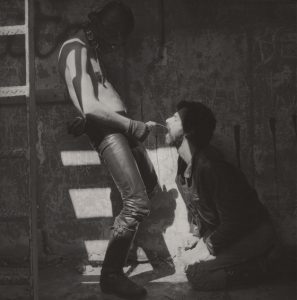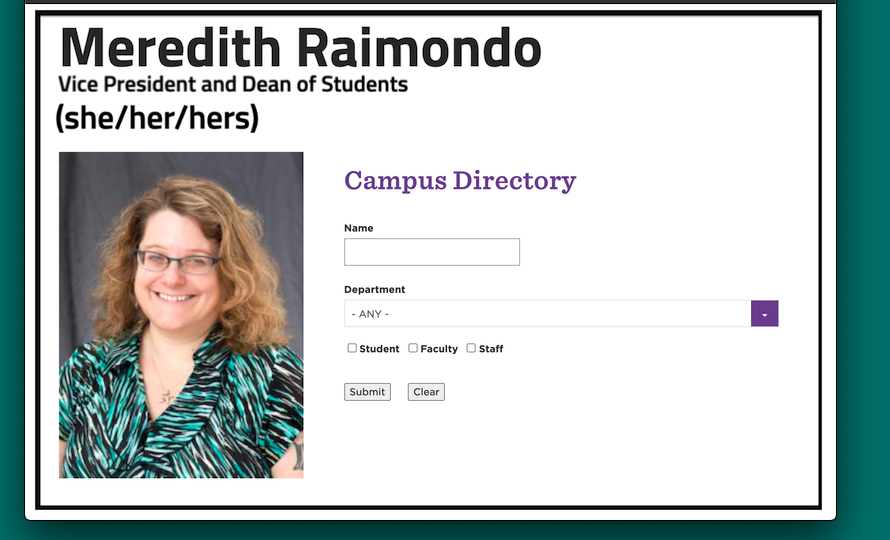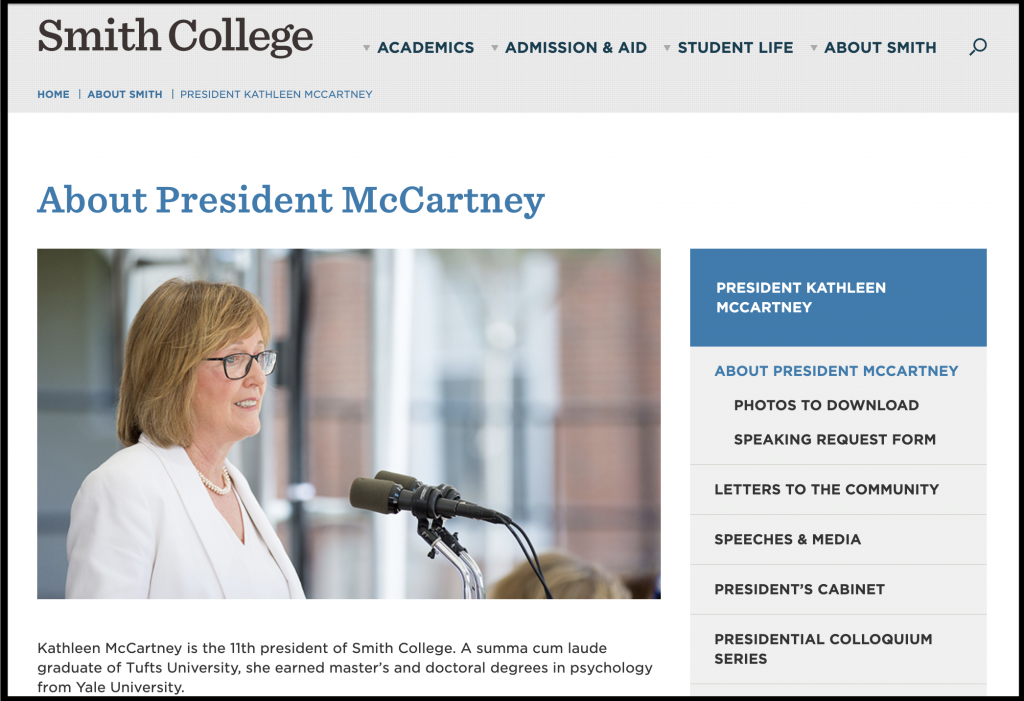Activism
Workers vs. Wokeness at Smith College: Campus Social Justice as a Luxury Good
For poor black people who live genuinely marginalized lives, and who will never set foot on a campus like Oberlin, racism is a real evil that affects their lives.

“While art has long maintained a symbiotic relationship with bourgeois state power, there’s still something deeply unsettling about our supposedly ‘radical’ artists manufacturing consent on behalf of one of our two entrenched capitalist parties,” wrote artist and self-described “culturally agnostic Marxist” Adam Lehrer in Caesura last month. By way of example, he cites an image circulated by visual artist Marilyn Minter in advance of this month’s US election, labeled, “How are you voting in 2020?” with the two choices labeled “Democrat” and “Fascist.” Lehrer argues that “Trump isn’t a fascist. He’s a symbol of the transformation of American empire and global capitalism.” And so “what Minter is doing is fusing conceptualist aesthetics with neoliberal politics and talking points. In doing so, she’s not just propagandizing on behalf of one faction of the elite, but also neutralizing art of its critical role.”
More broadly, Lehrer argues,
The cultural hegemony has shifted in the last 30 years as artists, intellectually trapped in the banal culture wars of the ‘90s and attracted to the intersectional aesthetics of [a] liberal elite (the [Democratic Party] and its backers in the surveillance state, Silicon Valley, and Wall Street), [that] willfully overlook[s] or latently support[s] the neoliberal and imperial politics of the elite. This is rank conformism. Artists, often precarious actors in a competitive marketplace, regurgitate these ‘left’ liberal reductive narratives simply because there is reward in doing so, or because they have unconsciously capitulated to social pressure, leading to a domino effect. As a result, the role of the artist has been reduced to that of the propagandist. This phenomenon is vampirically exsanguinating creativity itself: the freedom to challenge the orthodoxies of our culture, politics, and society.

Lehrer’s choice of words—“bourgeois state power,” “manufacturing consent,” “imperial politics of the elite”—marks him very much as a man of the Left (or what used to be the Left, at any rate). And his overarching thesis, that Democrats and Republicans are simply different factions of the same elitist “neoliberals,” is well in keeping with the revolutionary Marxist claim that mainstream electoral politics is a performative fraud that exists to perpetuate the status quo. But even those who find themselves put off by Lehrer’s radical political postures (a group that I’m guessing includes many Quillette readers) might want to give his essay a read, as it illustrates the extent to which progressive doctrines of social justice not only grate against classical liberalism, but also against the hallowed dogmas of socialism.
Or as Lehrer puts it, today’s “contemporary artists and art institutions form a propaganda apparatus that aids neoliberal capitalism in its quest to reinvent itself for compatibility with ‘wokeness’ and intersectionality.” They serve up “reductive bourgeois identitarianism” instead of “substantive class analysis.” And what’s more, the stifling climate of conformity within these milieus is crowdsourced from within, thanks to “social media-fueled collective anger.” So the “neoliberal” elites don’t even have to bear the moral burden of censorship, as they did in the old, pre-Twitter days when Jesse Helms would rail against the likes of Andres Serrano’s Piss Christ and Robert Mapplethorpe’s Jim and Tom, Sausalito.

Lehrer traces this phenomenon to the education system. As he sees it, “the art school has become a kind of ‘psy-op’ that indoctrinates young artists into identitarian neoliberalism and, by extension, ‘morally purifies’ the art world… Art schools can be understood as what [French Marxist philosopher] Louis Althusser called ‘ideological state apparatuses,’ institutions formally outside the state but in cahoots with it insofar as they reproduce state ideology.” That claim seems like a stretch, especially in Donald Trump’s America, where the federal government is suing universities for alleged bias against white and Asian students, even as students and professors have been drifting toward causes such as Black Lives Matter and Antifa. But it’s absolutely true that “substantive class analysis” has been ignored in favor of faddish ideological theories of race and gender, as illustrated by several recent campus confrontations that have pitted privileged students and academics against blue-collar campus-area workers.
* * *
Many readers are likely already aware of one of these incidents, because it became the subject of a widely followed legal saga. In November 2016, a black undergraduate student at Oberlin College in Ohio, an elite liberal-arts school, was caught trying to steal two bottles of wine from Gibson’s Bakery, a family-run business in the local town. When the theft attempt failed, a fracas ensued, drawing in two of the student’s friends, and the police came to make arrests. A police officer later testified that “we saw two young ladies standing over [the employee] and throwing [punches]. The two women would stand over him and kick him, and then crouch down and throw punches. As we got closer, we could see [Gibson] on his back, with the [shoplifting student] on top of him and punching him.”
The student later pled guilty to misdemeanor theft, and a black employee of the (white-owned) store made it clear that racism hadn’t been a factor in the confrontation: “If you’re caught shoplifting [at Gibson’s], you’re going to end up getting arrested… It doesn’t matter what color you are. You can be purple, blue, green; if you steal, you get caught, you get arrested.” But many Oberlin students, spurred on by their college administration, were convinced that racism was at play. In a message sent out on November 11th, 2016, three days after Donald Trump was elected president, Marvin Krislov, Oberlin’s president, and Meredith Raimondo, the vice president and dean of students, wrote as follows:
This has been a difficult few days for our community, not simply because of the events at Gibson’s Bakery, but because of the fears and concerns that many are feeling in response to the outcome of the presidential election. We write foremost to acknowledge the pain and sadness that many of you are experiencing. We want you to know that the administration, faculty, and staff are here to support you as we work through this moment together. Regarding the incident at Gibson’s, we are deeply troubled because we have heard from students that there is more to the story than what has been generally reported. We will commit every resource to determining the full and true narrative, including exploring whether this is a pattern and not an isolated incident. We are dedicated to a campus and community that treats all faculty, staff and students fairly and without discrimination. We expect that our community businesses and friends share the same values and commitments.
Oberlin’s Student Senate, meanwhile, passed a resolution to the effect that “the Students of Oberlin College immediately cease all support, financial and otherwise, of Gibson’s Food Market and Bakery,” and called on Krislov and Raimondo, by name, to publicly condemn Gibson’s. And sure enough, certain Oberlin officials joined in on the smear campaign. They also reportedly gave students class-participation credit for protesting the bakery. In a subsequent defamation trial—which Gibson’s won—the Gibson family produced evidence that Raimondo personally participated in street demonstrations against their business, bullhorn in hand, and distributed a flyer that stated the bakery is a “RACIST establishment with a LONG ACCOUNT of RACIAL PROFILING and DISCRIMINATION.” Oberlin also cancelled its weekly order from Gibson’s, after being ordered to do so by Raimondo. And when retired Oberlin professor Roger Copeland objected to all of this, Raimondo responded—in correspondence produced at trial—“Fuck him… I’d say unleash the students if I wasn’t convinced this needs to be put behind us.” In large part because Raimondo left such a clear evidence trail, Oberlin College is now on the hook for $25 million in damages.

Raimondo’s implied threat to “unleash the students” was damning, but it’s actually not clear who unleashed whom. The evidence produced suggests Raimondo and her fellow administrators wanted very much to validate the accusations of their students, and not the other way around. “What has happened in the Gibson case is that [Oberlin] doesn’t know what to do with its minority students,” a former school administrator told Daniel McGraw of the Washington Examiner. “A freshman from an east coast big city might come to Oberlin and find there is little for a social justice warrior to do in a small town like this, so they get frustrated. And make issues like this shoplifting thing bigger than it should be, and the school follows along.” (In fact, it’s not even clear whether the larger phenomenon being described here is about “minority students” per se. If you look at photos of the Oberlin-abetted protests outside Gibson’s, it’s hard to find many people who aren’t white.)
It costs about $75,000 for a student to attend Oberlin. And the students who enroll are overwhelmingly the sons and daughters of privilege. Increasingly, they arrive on campus with the expectation that their college experience will allow them to embody and express the social-justice postures they’ve been internalizing since grade school. And so, as the Gibson’s episode shows, administrators are under increasing pressure to feed the conceit that student life is a world of urgent social-justice controversies requiring heroic intervention.
Indeed, when the bakery brought statistics at trial showing that the racial mix of people arrested for shoplifting at Gibson’s over a five-year period perfectly matched the area’s racial makeup, the college’s lawyers tried (unsuccessfully) to quash the evidence. And that shouldn’t be a surprise because one of the greatest taboos one can utter on campus these days is, oddly, the somewhat obvious fact that elite college life doesn’t really feature that much racism. But if your parents are paying $75,000 a year on the expectation that you’ll have racism to fight, there’s a good chance that racism will be supplied, in some form, even if it has to be invented at the expense of a small business owner’s reputation.
While I’m no Marxist, it’s refreshing to read someone such as Lehrer let forth with a good old-fashioned Marxist critique. Quillette readers are used to authors tracing out the ideological sources of critical race theory and intersectionality. But what sometimes gets lost is that these doctrines, which effectively legitimize the conjuration of phantom oppression, have real economic value to administrators catering to rich, idealistic students. For poor black people who live genuinely marginalized lives, and who will never set foot on a campus like Oberlin, racism is a real evil that affects their lives. For wealthy white college kids, on the other hand, it’s a luxury good that gets bought and sold every time their wealthy parents write a tuition check.

This helps explain why, as Sarah Lawrence College professor Samuel J. Abrams has detailed, surveys of college administrators now show them to be more ideologically liberal than their academic colleagues. And again, this has more to do with supply and demand than esoteric discussions of critical theory. While many schools are cutting their academic staff, these are boom times for the bloated administrative and managerial offices that micromanage student life, and which are now tasked with caring for students who suffer even the mildest setbacks and inconveniences. (At the Oberlin trial, it was alleged that Raimondo’s underlings actually provided refreshments for the student protestors, and photocopied their libelous flyers for distribution—a level of babysitting that would have been unimaginable to the student protestors of yore, who railed against school administrators rather than collaborating with them.)
The University of Michigan alone has nearly 100 full-time diversity-related administrative workers, more than a quarter of whom earned in excess of $100,000 in 2018. And at nearby Michigan State University, the newly appointed diversity director will earn a $315,000 salary. These people aren’t getting hired to tell students to toughen up and hit the books. Just the opposite: Their livelihoods depend on upholding the idea that navigating campus life is a difficult struggle, punctuated frequently by invisible forms of bigotry whose negative effects can be managed only through the intervention of a professionalized corps of trained diversity officers.
As part of the larger trend by which leadership at colleges and universities has increasingly been taken over by professional business managers and other corporatized agents, these diversity officers have effectively become customer-service agents. And their work performance is graded according to the same crowdsourced indices of satisfaction that govern businesses on Tripadvisor. Raimondo distinguished herself by being unusually hyperactive and unprincipled in this capacity, but she is governed by the same incentive system as now exists on campuses everywhere. (And just in case you were wondering, yes, Raimondo is still at her job, having been personally liable for none of the massive defamation judgment against Oberlin that she helped bring about. Ironically, she is now being kept busy with claims that her own college’s COVID-19 public-health measures are, you guessed it, racist.)
The situation at Oberlin has received abundant coverage, in part because of the eye-popping libel award that Gibson’s received—and because of the human-interest backdrop. (The 90-year-old family patriarch, Allyn W. Gibson, was harassed at home for months by self-identified activists. One night, when he suspected more protestors were coming, he broke three vertebrae in his neck when he slipped and fell on his way to call 911.) But there are other widely reported examples of blue-collar workers being denounced by privileged academics in the name of social justice. At Cambridge University, Priyamvada Gopal, an outspoken academic in the field of “Anticolonial Resistance and British Dissent” launched a shaming campaign against porters (a British term for college security guards who also sort mail and perform maintenance duties) who called her “madam” instead of “Dr. Gopal” in 2018. (Gopal is also known for having tweeted that “white lives don’t matter,” which earned her a brief Twitter ban. Days later, she was promoted to a full Professorial Chair.) And this month, another Cambridge porter was denounced because his common-sense attitudes in regard to balancing women’s safety and gender expression were seen as troglodytic by the lights of the upper-class students who attend the school. Even offering a defense of the porter’s actions is now seen as an unprintable thoughtcrime.

Then there’s the extraordinary drama that unfolded at Smith College in Massachusetts two years ago, and whose repercussions are being felt on that campus to this day. As Smith administrative worker and whistleblower Jodi Shaw recently told Quillette podcast listeners, the controversy began in July 2018, when a custodial worker at Smith noticed someone improperly lounging in a room that had been declared off-limits. Following on normal workplace safety protocols, the worker made a perfunctory call to campus security, which dispatched an officer. (The building in question was then being used as a summer-camp facility for high-school students, and the presence of minors mandated a heightened level of vigilance.) When the officer arrived, he had a brief, friendly exchange with the interloper, who turned out to be someone he knew, a black Smith student-worker relaxing after lunch with her iPad. And that was it—until the student, Oumou Kanoute, went on Facebook and offered an (as it later turned out) error-riddled account of the incident, which she claimed was motivated by racism. “I have to check my closet at night now before I go to bed; I’m terrified in my own room,” Kanoute told a credulous CNN reporter. “I don’t even feel like leaving my room sometimes. I can’t sleep or eat, and all I want is this person to understand the predicament they’ve put me in.” And by “this person,” Kanoute meant the worker (whom Kanoute repeatedly sought to identify and dox. In one botched attempt, she publicly denounced a worker who wasn’t even on shift that day).
Needless to say, Smith’s administration treated the incident as something close to an attempted lynching. The school’s president, Kathleen McCartney, personally sent an email to the entire school community announcing that
…a student of color on the Smith campus was approached by Campus Police, because a Smith staff person reported seeing someone who appeared to be ‘out of place.’ I begin by offering the student involved my deepest apology that this incident occurred and to assure her that she belongs in all Smith spaces. This painful incident reminds us of the ongoing legacy of racism and bias in which people of color are targeted while simply going about the business of their daily lives. It is a powerful reminder that building an inclusive, diverse and sustainable community is urgent and ongoing work.
But as it turned out, the truly “painful” part of the whole ordeal was the false accusations of racism made against the worker and her kitchen-staff colleagues (one of whom is identified as “the Dining Employee” in the material that follows). An exhaustive investigation, whose results have been made public (albeit in redacted form), completely exonerated everyone involved:
The investigation did not find that the Dining Employee engaged in the behaviors complained of by the Reported Party [i.e., Oumou Kanoute]. The investigation determined that the Caller [i.e., the custodial employee] had a legitimate, non-discriminatory reason for contacting the Campus Police, and there was insufficient information to conclude that the Caller’s stated reason was a pretext for discrimination on the basis of the Reported Party’s race or color, in violation of the Policy. Nor did the investigation find evidence that Responding Officer or Dispatcher violated the Policy by discriminating against the Reported Party on the basis of race or color. As indicated above, the Dispatcher was not aware of the race or color of the Reported Party when he dispatched the Responding Officer, and the Responding Officer was unaware of the Reported Party’s race or color until he entered the room, at which time he recognized her as a student. No information reflected that, when in the room, the Responding Officer responded to the Incident based on the Reported Party’s race or color. Accordingly, this report did not determine that the Dining Employee, the Caller, the Dispatcher, or the Responding Officer, violated the Policy in connection with the Incident.
It’s important to emphasize that racist incidents happen all the time. And we don’t know what Kanoute—whose public LinkedIn page now lists her as a research intern at Columbia, developing “innovative ways to conceptualize and measure racism”—had to put up with earlier in life. But her accusations against these Smith workers were taken extremely seriously, and were investigated with an almost surreal level of scrutiny and zeal. (The 35-page report on the incident comes with no fewer than 135 pages of exhibits, including three photos of a giant teddy bear that obscured the custodial worker’s view of Kanoute at the time he made the call to campus security.) In their search for racism, the investigators even pored over years’ worth of Smith’s security-service incident-response records. They found absolutely nothing to substantiate McCartney’s dramatic claim that “this painful incident reminds us of the ongoing legacy of racism and bias in which people of color are targeted while simply going about the business of their daily lives.” And while Ms. McCartney sent out a link to the investigators’ report, she never retracted her implied slur against the people who work menial jobs for the benefit of her privileged faculty and students.
The whole episode shows how bizarrely eager university administrations are to inflate the conceit that their own campuses are beehives of bigotry. And I know of no other industry outside of academia—except perhaps electoral politics—in which industry leaders seek to exaggerate the supposedly toxic nature of their own workplaces. One would be hard-pressed to find, say, a steel mill or food processing plant that churns out press releases about the horrible conditions suffusing their facilities. Yet on campus, this self-flagellation has become the stuff of everyday stakeholder management: As in all markets, the customer is always right, and what these customers want is the belief that they are surrounded by racism.
As Shaw has noted, the October 2018 investigators’ report debunking claims of racism at Smith didn’t dampen President McCartney’s campaign of social-justice messaging. Very much the opposite. On January 30th, 2019, she sent a statement to the school community that read, in part, as follows: “As you know, a painful event led us to reassess and recommit to making Smith a place where each of us feels included and valued. I have heard from so many members of the Smith community—students, staff, faculty and alumnae—about ways to move forward. Many efforts are underway, including training workshops to help us all learn how to have critical conversations to advance our inclusion and equity goals.” She also announced an April 10th “inclusion conference” for the whole school. On July 14th, 2020, even as she was furloughing some of the same workers whom she’d implied were in need of ideological correction, President McCartney announced that she was sharing a plan titled Toward Racial Justice at Smith College, signaling a wave of new programs designed to root out institutional racism.
These included: “acknowledging that our country was built on lands originally belonging to Indigenous peoples and with stolen labor performed by enslaved Africans and their descendants,” possibly forcing all students to take a course called “Thinking Through Race,” and expanding a program by which professors must “complete a Faculty Record Sheet annually, which prompts reflection on their contributions to equity and inclusion.” Indeed, the word “reflect” or “reflections” appears 13 times in the two-page document, which presents members of the school community as fallen creatures who sit in silent, guilty contemplation as a means to rid themselves of ideological contaminants. Shaw reports that the reason she finally went public with her complaints about all this is that professional development on campus now consists largely of endlessly hectoring about race—culminating, in her case, in Shaw being humiliated in front of colleagues when a third-party equity consultant instructed her to describe her feelings about being white.

Shaw is not only a staffer at Smith College, but also a graduate. Even so, she was one of the few members of her class with working-class roots. (Her parents operated a restaurant in New Hampshire.) This fact doesn’t strike me as a coincidence, given that the events of 2018 essentially amounted to a cancel campaign waged by wealthy and privileged students and administrators at an elite college against the blue-collar staff who cook their meals and empty their trash cans.
“I was a librarian at the Brooklyn Public Library,” she told Quillette listeners. “I can’t think of a more diverse organization or clientele. I think that people coming from working-class backgrounds—I feel like they have more developed bullshit detectors. [The] virtue signaling [I see on campus]. It’s people letting each other know ‘I’m in this club’ and ‘I’m in the know,’ separating yourself from other people who don’t know the latest speech or language. This is so divisive. It’s like putting up wall upon wall upon wall.”
A typical entry-level administrative staffer at Smith makes about $35,000 to $40,000 per year by Shaw’s estimation, about half of what full annual tuition and fees cost for Smith students. President Kathleen McCartney, by contrast, was listed in 2016 as the highest-paid private university or college president in her region, earning $560,000 in total compensation—which is more than those false-accused Smith College custodial and kitchen workers make in a decade. In fairness, however, I should note that several months ago, amid an $8 million to $10 million budget shortfall caused by the pandemic, President McCartney announced to the school community that she’d agreed to a voluntary 20% pay cut, adding that “by pulling together, we will come through this, and assure that Smith—and Smithies—will be prepared to lead the way.”
Correction: President Kathleen McCartney was listed in 2016 as the highest-paid private university or college president in her region, earning $560,000 in total compensation. The original version of this article incorrectly stated that she earned more than any other university or college president nationally.






